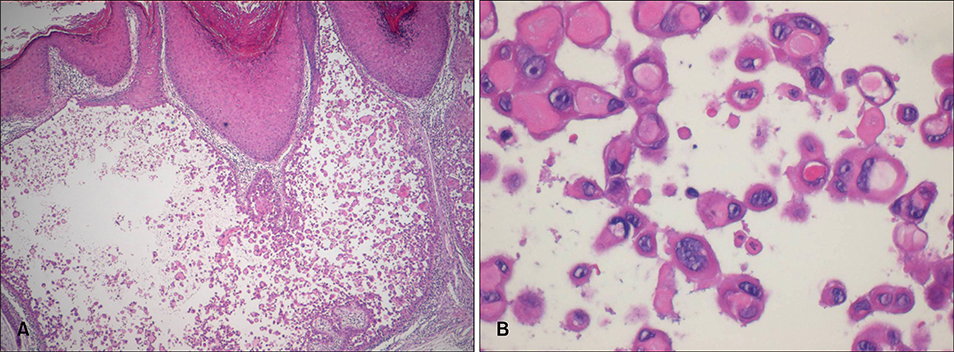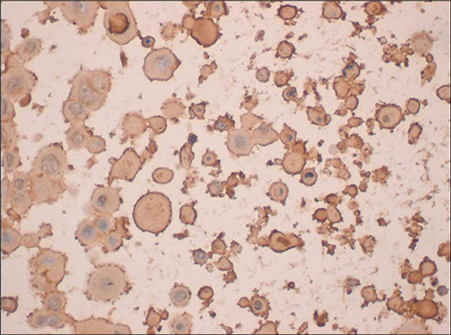Ann Dermatol.
2008 Dec;20(4):267-270. 10.5021/ad.2008.20.4.267.
A Case of Acantholytic Squamous Cell Carcinoma
- Affiliations
-
- 1Department of Dermatology, School of Medicine, Ewha Womans University, Seoul, Korea.
- 2Department of Dermatology, Ilsan Paik Hospital, Inje University School of Medicine, Goyang, Korea.
- 3Department of Dermatology, Seoul Paik Hospital, Inje University School of Medicine, Seoul, Korea.
- 4Serion Dermatology Clinic, Seoul, Korea. skinewkk@ewha.ac.kr
- KMID: 2156412
- DOI: http://doi.org/10.5021/ad.2008.20.4.267
Abstract
- Acantholytic squamous cell carcinoma is a well-defined variant of squamous cell cancer in which significant portions of the neoplastic proliferation show a pseudoglandular or tubular microscopic pattern. It usually presents as a nodule with various colors, and it is accompanied by scaling, crusting, and ulceration on the sun-exposed areas of older aged individuals. Histologically, the tumor consists of a nodular, epidermal-derived proliferation that forms island-like structures. At least focally or sometimes extensively, the tumor cells shows a loss of cohesion within the central gland-like or tubular spaces. This tumor resembles the structure of eccrine neoplasms, but it is negative for dPAS, CEA and mucicarmine and it is only positive for EMA and cytokeratins. Herein we report a case of acantholytic squamous cell carcinoma that occurred on the face of an 82-year-old woman.
Keyword
MeSH Terms
Figure
Reference
-
1. Cassarino DS, Derienzo DP, Barr RJ. Cutaneous squamous cell carcinoma: a comprehensive clinicopathologic classification. Part one. J Cutan Pathol. 2006; 33:191–206.
Article2. Kane CL, Keehn CA, Smithberger E, Glass LF. Histopathology of cutaneous squamous cell carcinoma and its variants. Semin Cutan Med Surg. 2004; 23:54–61.
Article3. Lever WF. Adenoacanthoma of sweat glands: carcinoma of sweat glands with glandular and epidermal elements: report of 4 cases. Arch Derm Syphilol. 1947; 56:157–171.4. Lohmann CM, Solomon AR. Clinicopathologic variants of cutaneous squamous cell carcinoma. Adv Anat Pathol. 2001; 8:27–36.
Article5. Johnson WC, Helwig EB. Adenoid squamous cell carcinoma (adenoacanthoma). A clinicopathologic study of 155 patients. Cancer. 1966; 19:1639–1650.
Article6. Muller SA, Wilhelmj CM Jr, Harrison EG Jr, Winkelmann RK. Adenoid squamous cell carcinoma (adenoacanthoma of Lever). Arch Dermatol. 1964; 89:589–597.
Article7. Underwood JW, Adcock LL, Okagaki T. Adenosquamous carcinoma of skin appendages (adenoid squamous cell carcinoma, pseudoglandular squamous cell carcinoma, adenocanthoma of sweat gland of Lever) of the vulva: a clinical and ultrastructural study. Cancer. 1978; 42:1851–1858.
Article8. Toyama K, Hashimoto-Kumasaka K, Tagami H. Acantholytic squamous cell carcinoma involving the dorsum of the foot of elderly Japanese: clinical and light microscopic observations in five patients. Br J Dermatol. 1995; 133:141–142.
Article9. Lasser A, Cornog JL, Morris JM. Adenoid squamous cell carcinoma of the vulva. Cancer. 1974; 33:224–227.
Article10. Watanabe K, Mukawa A, Miyazaki K, Tsukahara K. Adenoid squamous cell carcinoma of the penis. Report of a surgical case clinically manifested with rapid lung metastasis. Acta Pathol Jpn. 1983; 33:1243–1250.
Article11. Takagi M, Sakota Y, Takayama S, Ishikawa G. Adenoid squamous cell carcinoma of the oral mucosa: report of two autopsy cases. Cancer. 1977; 40:2250–2255.
Article12. Zaatari GS, Santoianni RA. Adenoid squamous cell carcinoma of the nasopharynx and neck region. Arch Pathol Lab Med. 1986; 110:542–546.13. Eusebi V, Lamovec J, Cattani MG, Fedeli F, Millis RR. Acantholytic variant of squamous-cell carcinoma of the breast. Am J Surg Pathol. 1986; 10:855–861.
Article14. Nappi O, Pettinato G, Wick MR. Adenoid (acantholytic) squamous cell carcinoma of the skin. J Cutan Pathol. 1989; 16:114–121.
Article15. Petter G, Haustein UF. Histologic subtyping and malignancy assessment of cutaneous squamous cell carcinoma. Dermatol Surg. 2000; 26:521–530.
Article16. Tot T. Cytokeratins 20 and 7 as biomarkers: usefulness in discriminating primary from metastatic adenocarcinoma. Eur J Cancer. 2002; 38:758–763.17. Kaufmann O, Fietze E, Dietel M. Immunohistochemical diagnosis in cancer metastasis of unknown primary tumor. Pathologe. 2002; 23:183–197.
Article18. Petter G, Haustein UF. Squamous cell carcinoma of the skin--histopathological features and their significance for the clinical outcome. J Eur Acad Dermatol Venereol. 1998; 11:37–44.
Article
- Full Text Links
- Actions
-
Cited
- CITED
-
- Close
- Share
- Similar articles
-
- Acantholytic Squamous Cell Carcinoma on the Right Foot
- A Case of Adenoid Squamous Cell Carcinoma
- A Case of Adenoid Squamous Cell Carcinoma
- A Case of Acantholytic Squamous Cell Carcinoma on a Male Areola: An Uncommon Histologic Variant at a Rare Location
- Immunohistochemical Study of Acantholytic Cells of the Squamous Cell Carcinoma of the Skin




